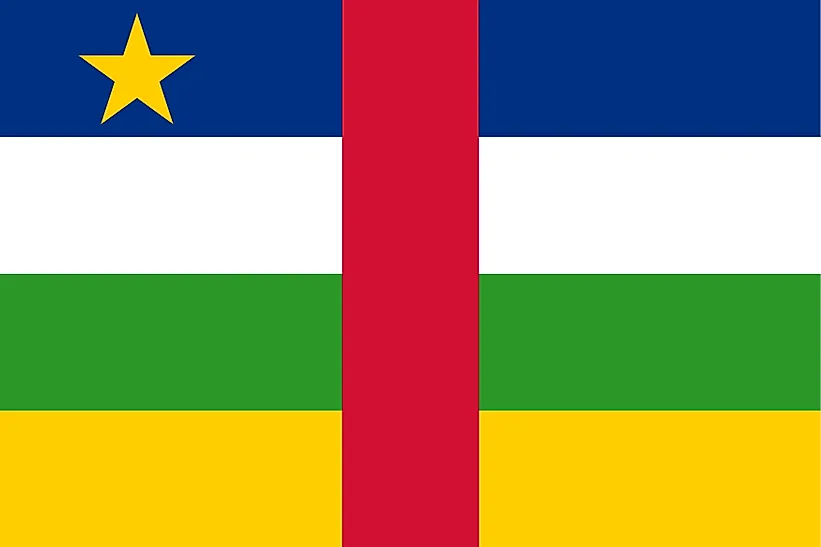
Central African Republic
| Continent | Africa |
| Capital | Bangui |
| Population | 5,507,257 |
| GDP | $3.21 Billion |
| GDP per Capita | $700 |
| Dialing Code | +236 |
| ISO Code (2-letter) | CF |
| ISO Code (3-letter) | CAF |
Central African Republic Landscapes






About Central African Republic
Welcome to the Central African Republic (CAR), a landlocked nation situated at the geographic heart of Africa. With approximately 5.4 million people occupying 622,984 square kilometers, this country combines vast natural resources and remarkable biodiversity with a rich cultural heritage. Despite facing significant challenges, the Central African Republic holds immense potential in its natural wealth and the resilience of its people.
Geographic Features and Natural Beauty
The Central African Republic’s geography is characterized by vast savannas, dense equatorial rainforests, and dramatic river systems. The country lies on a vast plateau, with elevations ranging from 600 to 800 meters above sea level. The Ubangi and Chari Rivers form major waterways that have historically served as vital transportation routes.
The Dzanga-Sangha Special Reserve in the southwest showcases the country’s extraordinary biodiversity, including forest elephants, western lowland gorillas, and numerous primate species. The Manovo-Gounda St. Floris National Park, a UNESCO World Heritage site, features extensive savannas and diverse wildlife.
The country’s climate varies from tropical in the south to Sahelo-Sudanian in the north, creating diverse ecosystems that support a wide range of flora and fauna.
Cultural Heritage and Traditions
Central African culture is rich and diverse, with over 80 ethnic groups maintaining their distinct traditions, languages, and customs. The Banda, Gbaya, Mandjia, and Sara peoples represent some of the largest ethnic groups, each contributing to the nation’s cultural mosaic.
Traditional arts and crafts include intricate basketwork, pottery, and wooden sculptures. Music and dance play central roles in cultural life, with each ethnic group maintaining its own distinctive musical traditions and ceremonies.
The country’s cuisine reflects its agricultural heritage, featuring staples like cassava, plantains, and peanuts. Bushmeat and fish from the country’s rivers traditionally supplement the diet in many areas.
Historical Journey
The Central African Republic’s history spans from ancient kingdoms and trading routes to French colonization. The region was historically significant in trans-Saharan trade networks and was impacted by the slave trade during the colonial period.
The country gained independence from France in 1960 and has since experienced various political challenges. Despite these difficulties, the Central African Republic maintains a rich cultural heritage and continues to work toward stability and development.
Modern Economic Landscape
Today’s Central African Republic has an economy based primarily on agriculture, forestry, and mining. The country possesses significant natural resources, including diamonds, gold, uranium, and timber. Subsistence agriculture employs the majority of the population, with cotton and coffee being important cash crops.
The country has significant potential for eco-tourism development, particularly in its protected areas which host unique wildlife populations. The government has been working to develop infrastructure and attract investment in various sectors.
International Relations and Global Position
The Central African Republic maintains active participation in regional organizations and works with various international partners on development and peacekeeping initiatives. The country is a member of the Economic Community of Central African States (ECCAS) and other regional bodies.
Did You Know?
• The Central African Republic is home to some of Africa’s last remaining pristine rainforests?
• The country hosts one of the continent’s highest concentrations of forest elephants?
• Traditional Central African music has influenced modern Congolese rumba and other African musical styles?
• The Dzanga-Sangha Reserve is one of the best places in Africa to observe western lowland gorillas in their natural habitat?
Conclusion
The Central African Republic represents a nation of immense natural wealth and cultural diversity working to overcome significant challenges. From its vast savannas to its dense rainforests, from its traditional cultures to its modern aspirations, the country continues to strive for development and stability. As it faces contemporary challenges, the Central African Republic remains focused on harnessing its natural resources and human potential for sustainable development while preserving its unique cultural and natural heritage.